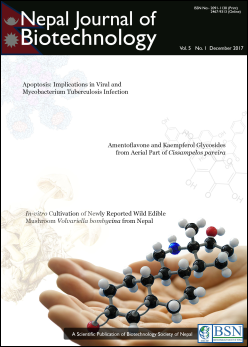Prevalence of Extended Spectrum Beta-Lactamase Producing Escherichia coli and Klebsiella species from Urinary Specimens of Children attending Friendship International Children’s Hospital
DOI:
https://doi.org/10.3126/njb.v5i1.18868Keywords:
Urinary tract infection(UTI), Extended spectrum beta lactamase(ESBL), E. coli, KlebsiellaAbstract
Extended-spectrum β-lactamase producing E. coli and K. pneumoniae is a serious threat to the patients. These organisms are major extended spectrum beta lactamase (ESBL) producers. The objective of this study was to determine the prevalence of Extended spectrum β- lactamase producing strains of Escherichia coli and Klebsiella spp isolates from the urine sample of children visiting International Friendship Children Hospital. During the seven months, between June 2016 to December 2016, 1018 mid-stream urine samples(MSU) were collected from patients suspected of having UTI. The samples were investigated by conventional semi-quantitative culture technique and identification of E. coli and Klebsiella spp. was done by microscopy and biochemical test. Antibiotic susceptibility test of isolates was performed by modified Kirby Bauer Disc diffusion test. ESBL screening test was done by using 3rd generation Cephalosporin and confirmation done by combination disc diffusion method. Out of total 1018 MSU samples investigated, 200(19.64%) isolates of E. coli and 28(2.7%) isolates of Klebsiella spp. making a total of 228(22.39%) were found to cause significant bacteriuria. 76(33.33%) isolates, from those causing significant bacteriuria, were Multi-drug resistant organisms. Out of 228 isolates, 54(23.68%) were ESBL producers, that includes 51(25.5%) Escherichia coli and 3(12.5%) Klebsiella pneumoniae. ESBL producers were more common in in-patient (36.17%) than out-patient (20.44%). Most of the ESBL producers were resistance to amoxicillin, followed by Cotrimoxazole and Ciprofloxacin respectively. They were highly sensitive to Imipenem, Tigecycline, Amikacin, Piperacillin-Tazobactam, and Nitrofurantoin. High prevalence of ESBL producing E. coli and Klebsiella pneumoniae was found among children. Regular and routine monitoring of ESBL producing isolates is essential.
Nepal Journal of Biotechnology. Dec. 2017 Vol. 5, No. 1: 32-38
Downloads
Downloads
Published
How to Cite
Issue
Section
License
Copyright Notice:
The manuscript submitted to NJB must be an original contribution, not previously published and should not be under consideration for publication elsewhere. When the manuscript is accepted for publication, the authors agree to automatically transfer the copyright of the article to the publisher. It should grant permission to any third party, in advance and in perpetuity, the right to use, reproduce or disseminate your article, according to the NJB copyright and license agreement.
Authors transfer copyright to the publisher as part of a journal publishing agreement but have the rights to: Share their article for Personal Use, Internal Institutional Use and Scholarly Sharing purposes, with the NJB applies the Creative Commons Attribution-NonCommercial CC BY-NC license to all the works we publish after Jun 2020 (Before it was CC BY-NC-ND). Under this license, authors agree to make articles legally available for reuse, without permission or fees, for virtually any non-commercial purpose. Anyone may remix, adapt, and build upon your work non-commercially, and although their new works must also acknowledge you and be non-commercial, they don’t have to license their derivative works on the same terms. More details on CC BY-NC refer to its Licence Deed and Legal Code.






